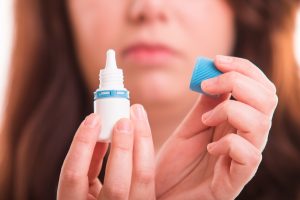Types of Eye Drops: Learning the Difference

Varieties of Eye Drops
Over-the-counter (OTC) eye drops treat minor ailments and eye discomfort. You can achieve favorable results with many OTC brands if you read instructions carefully and use the drops as directed. A few advantages of OTC drops are easy accessibility and lower cost.
Irritation caused by chronic conditions may need to be treated with prescription eye drops recommended by an ophthalmologist or optometrist. Some OTC eye drops have a prescription-strength version that contains a higher percentage of active ingredients, but you’ll have to see your eye doctor to request a prescription.
Drops for Dry Eye
Eye irritation and dryness is common, especially in the fall and winter. Most minor cases of dryness respond well to lubricating drops or artificial tears, but these drops may not alleviate the symptoms. If OTC drops do not soothe the scratchy, irritated, burning sensation from dry eye, call your ophthalmologist. You may be one of 30 million Americans who suffer from chronic dry eye and would benefit from a prescription eye drop.
Drops for Redness
Decongestant drops can help clear away redness by constricting blood vessels in the eye. If redness persists, schedule a check-up with your eye doctor. Overusing decongestant drops can make the redness problem worse.
Drops for Allergies
Allergens like grass, dust, mold, spores and pet dander can cause the body to release histamines that trigger eye irritation, redness and watering. OTC and prescription eye drops that contain antihistamines can block the histamine that initiates the allergic response.
Antibiotic drops
Bacterial infections like pink eye require prescription antibiotic drops to reduce symptoms and bring healing. Antibiotic drops are also prescribed after eye surgery to prevent infection. These drops are not available over the counter.
Rewetting drops
Contact lenses wearers can get relief using OTC rewetting drops to add moisture when contacts feel dry.
Glaucoma drops
One treatment method for glaucoma is prescription eye drops which help maintain safe levels of internal eye pressure. These drops are only available with a prescription and the dosage is carefully monitored by an ophthalmologist.
Make an Appointment with Your Eye Doctor
Eye drops can soothe irritation, treat infection and maintain healthy vision when used as directed. Call a board-certified ophthalmologist to schedule an appointment for a comprehensive eye exam and an evaluation of your eye care regimen.
